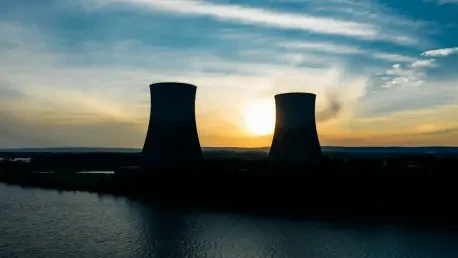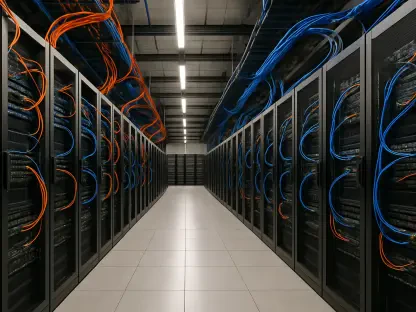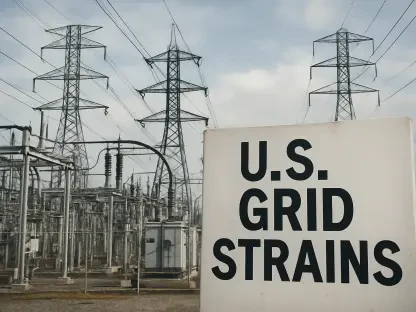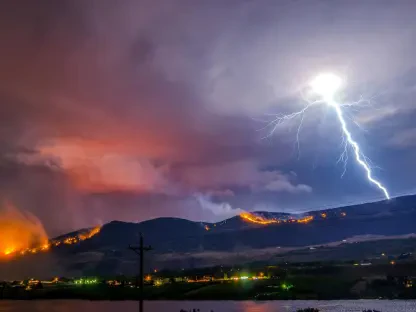In a rapidly evolving energy sector, Christopher Hailstone stands out with his extensive expertise in energy management, renewable energy, and electricity delivery. Known for his authoritative insights into grid reliability and security, Hailstone shares his thoughts on the upcoming restart of the Three Mile Island nuclear plant. Fast-tracked to power Microsoft’s data centers, the project symbolizes a monumental shift in the nuclear power landscape—a resurgence driven by growing electricity demands and tech industry needs.
Can you explain the significance of the fast-tracking of the Three Mile Island restart for Microsoft data centers?
The fast-tracking of the Three Mile Island restart is pivotal for Microsoft because their data centers are experiencing an unprecedented increase in demand for electricity, fueled by artificial intelligence and cloud computing expansion. Renewed use of nuclear power offers a reliable, sustainable energy source that aligns with Microsoft’s long-term commitments to both energy efficiency and carbon reduction. This expedited process ensures that these centers can continue operating at full capacity without compromising energy sustainability goals, highlighting how vital energy management optimization is for tech giants.
What role does PJM play in the process of reconnecting the Three Mile Island plant to the regional grid?
PJM Interconnection serves as the fundamental link between the plant and the regional grid, which spans 13 states and the District of Columbia. PJM’s role is critical; they manage the logistical and technical requirements to ensure that the power generated by Three Mile Island seamlessly integrates into the existing grid infrastructure. By fast-tracking the interconnection process, PJM is alleviating bottlenecks that could delay such projects. It showcases their adaptability and responsiveness to the evolving needs of large-scale consumers like data centers.
How did the deal with Microsoft influence Constellation’s decision to reopen Three Mile Island?
The agreement with Microsoft was a catalyst for Constellation’s decision to revive the Three Mile Island plant. This power purchase agreement exemplifies the extent to which companies like Microsoft are investing to meet their expanding energy needs. For Constellation, this deal not only guaranteed a steady revenue stream over many years but also set a precedent for how partnerships between technology firms and energy companies can drive significant developments in energy infrastructure.
What specific technological needs of Microsoft’s data centers influenced this decision?
Microsoft’s data centers demand an enormous and increasingly stable power supply to support sophisticated AI systems and vast amounts of cloud storage. Emerging technologies like AI require constant power, free from fluctuations that could impair operations. Nuclear energy offers the constant and reliable power supply essential for these functions, particularly in juxtaposition to renewable energies that can be subject to intermittent generation patterns.
Why was the Three Mile Island plant originally shut down in 2019 for economic reasons, and what has changed since then to warrant a restart?
In 2019, the economic landscape didn’t favor nuclear power, mainly due to the competitive pricing of natural gas and renewable alternatives. However, the growing demand for reliable and sustainable electricity, coupled with newfound financial partnerships, has reshaped the economics. The fast-paced technological advancements that demand steadier power sources have also contributed, making the plant’s revival economically viable.
Could you describe the process and challenges involved in readying the plant for its 2027 reopening?
Reopening a nuclear plant involves intricate preparation, including upgrading technology and infrastructure, ensuring regulatory compliance, and implementing rigorous safety protocols. The key challenges lie in managing the complex logistics of acquiring necessary components, like transformers and fuel, and re-establishing operational water systems—all vital for the safe and efficient operation of the plant.
What steps have been taken to ensure safety and compliance since the plant’s shutdown?
Safety and compliance are cornerstones of nuclear energy projects, especially given Three Mile Island’s history. Since the shutdown, rigorous inspections and evaluations have been carried out to address any potential risks. Constellation has worked closely with regulatory bodies to ensure the plant meets all safety standards and has ordered critical components to update and fortify systems for renewed operations.
What are some of the key items Constellation has ordered for the restart process, and why are they important?
Crucial items like the main transformer and specific fuel have been ordered, each playing an essential role in the energy generation and distribution processes. These components ensure that the plant operates efficiently, delivering reliable electricity to Microsoft data centers while adhering to updated industry standards. Modern replacements significantly contribute to the plant’s reliability and minimize environmental impact.
How has the company addressed wait times and potential delays associated with connecting power projects to PJM’s regional grid?
Constellation has proactively collaborated with PJM to streamline the interconnection process, securing expedited permits and technical evaluations. By prioritizing this project in the queue, PJM mitigates traditional delays, adapting their method to accommodate the rapid growth of data centers and ensuring a timely power supply, thus addressing the critical need for swift integration into the regional grid.
Are there any unique challenges associated with restarting a fully shut nuclear power plant?
Restarting a dormant nuclear plant like Three Mile Island presents unique challenges, primarily rooted in technical and regulatory hurdles. It’s unprecedented, requiring enhanced engineering and operational rigor to ensure safety and functionality. The plant’s historical context adds layers of scrutiny, demanding thorough compliance and safeguarding measures that meet modern-day standards.
How have past nuclear projects informed Constellation’s approach to the Three Mile Island restart?
Constellation has drawn from lessons learned in past projects, emphasizing the importance of comprehensive planning and regulatory collaboration. Their approach involves leveraging prior success stories and failures to strategize effectively—prioritizing safety, compliance, and community engagement to ensure better outcomes and avoid pitfalls that have historically beleaguered similar ventures.
Can you discuss the broader resurgence of interest in nuclear power amidst growing electricity demands in the U.S.?
The resurgence of interest in nuclear power is largely driven by growing demands that renewables alone can’t meet. As electricity consumption skyrockets, industries seek non-intermittent power sources. Nuclear energy offers a reliable alternative, combining consistent output with reduced greenhouse gas emissions, fitting neatly into the nation’s evolving energy portfolio aimed at sustainability and stability.
What role are data centers and the tech industry playing in the increasing demand for nuclear power?
Data centers and the tech industry are primary drivers. Their consistent, escalating energy requirements far exceed what renewable resources can supply steadily. Therefore, nuclear power becomes essential, providing the reliable and vast energy supply these facilities need to manage data-intensive tasks and cutting-edge technological advancements without interrupting operations.
How do you see the Three Mile Island project fitting into Pennsylvania’s and the nation’s future energy landscape?
The restart of Three Mile Island symbolizes a shift in understanding and incorporating nuclear power into a balanced energy strategy. For Pennsylvania, it represents a commitment to reviving infrastructure and meeting state energy objectives. Nationally, it sets a precedent for embracing nuclear energy as a core component of future energy policy—contributing to reliability and energy independence.
Could you describe the job creation impact of this project on the local community?
This project has already begun revitalizing the job market, as evidenced by the hiring of over 400 individuals for various roles. Local employment opportunities range from engineering and construction to specialized nuclear operations. With training initiatives for operators, the project also promises to skill up the community workforce, fostering long-term economic benefits.
How important is the training of operators who will work in the control rooms for the reopened plant?
Operator training is crucial—ensuring those who manage day-to-day operations are well-versed in safety protocols and plant mechanics. As operators are vital to maintaining the plant’s safety and efficiency, comprehensive training programs are designed to cover technical, emergency, and procedural aspects, equipping personnel to handle any scenario that might arise during operations.
How does Constellation plan to address any public concerns about nuclear safety given the history of the 1979 partial meltdown?
Addressing public concerns involves transparency and communication from Constellation’s side. By openly engaging with the community and demonstrating adherence to strict safety standards, the company works to reassure stakeholders. Education campaigns paired with openness about safety advancements and protocols play a pivotal role in rebuilding trust and dispelling anxieties tied to past mishaps.
How is the Pennsylvania government supporting the fast-tracking of this project, and what role is Governor Josh Shapiro playing?
The Pennsylvania government, with Governor Josh Shapiro at the helm, is championing the project as a means to boost the state’s energy capabilities. Shapiro’s advocacy reflects a commitment to modernizing infrastructure. By working closely with PJM and Constellation, the government is driving a streamlined approval process, ensuring the restart progresses without undue hindrances.
Can you elaborate on the role and expectations of the Nuclear Regulatory Commission in overseeing this restart?
The Nuclear Regulatory Commission plays a critical oversight role, ensuring all safety, environmental, and operational standards are rigorously upheld. Their involvement encompasses reviewing plant modifications, supervising the training of operators, and conducting ongoing assessments to guarantee the reactivation meets federal safety requirements. Their vigilance is key to this project’s success.
What measures are being taken to ensure that the reopening aligns with Constellation’s and Microsoft’s sustainability commitments?
Aligning with sustainability commitments involves integrating efficient technologies and processes that reduce emissions and waste, capitalizing on nuclear’s low-carbon footprint. Constellation is investing in sustainable practices across the board, ensuring Microsoft’s stringent eco-friendly criteria are met, thus fostering a synergy between operational efficiency and environmental custodianship.
How do the timelines and cost projections for the Three Mile Island restart compare to other nuclear projects, both past and present?
This project is ambitious, with expedited timelines aimed at 2027, contrasting with historical and current projects that often span decades. Proactive coordination and collaboration have minimized delays typically seen in such undertakings. By innovatively managing this restart, both costs and timelines will reflect a modernized approach focusing on efficiency, adaptability, and foresight, diverging from past nuclear endeavors.









